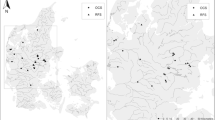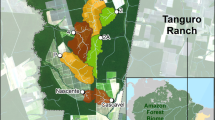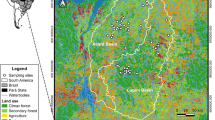Abstract
Deforestation of riparian areas is a major driver of biodiversity loss in aquatic ecosystems. Thus, we investigated the influence of forest cover and physical and chemical characteristics of streams on zooplankton communities in the southeastern Amazon. We addressed the following questions: (1) Are environmental factors (water physical and chemical characteristics and landscape variables) and dispersive processes (reflected in the spatial structure among sampling sites) efficient predictors of zooplankton communities in different hydrologic seasons? (2) Can zooplankton species be indicators of watersheds’ forest-cover levels? We sampled 15 streams located in nine rural settlements in northern Mato Grosso, Brazil, in the dry (August) and rainy (March) seasons of 2017. The forest-cover level had a significant effect on the physical and chemical characteristics (conductivity, dissolved oxygen, and temperature) of streams and also on the structure and composition of zooplankton communities, mainly of rotifers and testate amoebae. Areas with low vegetation cover had seasonal changes in species richness, individuals density, and zooplankton community structure. Environmental and spatial variables had no significant effect on the structure of zooplankton communities, which may indicate the strong influence of stochastic factors. Species from three zooplankton groups (rotifers, microcrustaceans, and testate amoebae) were indicators of forest-cover classes. This study provided valuable contributions to the conservation of riparian ecosystems and the use of biological indicators in environmental monitoring programs.

Similar content being viewed by others
References
Alaoui A, Rogger M, Peth S, Blöschl G (2018) Does soil compaction increase floods? A review. J Hydrol 557:631–642
Alencar A, Pereira C, Castro I et al (2015) Desmatamento nos Assentamentos da Amazônia: histórico, tendências e oportunidades. IPAM, Brasília, DF
ANA (2006) Topologia hídrica: método de construção e modelagem da base hidrográfica para suporte à gestão de recursos hídricos: versão 1.11
APHA (2005) Standard methods for the examination of water and wastewater, 21st edn. American Public Health Association/American Water Works Association/Water Environment Federation, Washington DC
Arimoro FO, Oganah AO (2010) Zooplankton community responses in a perturbed tropical stream in the Niger Delta, Nigeria. Open Environ Biol Monit J 3(1):1–11. http://dx.doi.org/%2010.2174/1875040001003010001
Astorga A, Oksanen J, Luoto M et al (2012) Distance decay of similarity in freshwater communities: do macro-and microorganisms follow the same rules? Glob Ecol Biogeogr 21:365–375
Attayde JL, Bozelli RL (1998) Assessing the indicator properties of zooplankton assemblages to disturbance gradients by canonical correspondence analysis. Can J Fish Aquat Sci 55:1789–1797
Bailly D, Cassemiro FAS, Winemiller KO et al (2016) Diversity gradients of Neotropical freshwater fish: evidence of multiple underlying factors in human-modified systems. J Biogeogr 43:1679–1689
Bambi P, de Souza RR, Feio MJ et al (2017) Temporal and spatial patterns in inputs and stock of organic matter in savannah streams of Central Brazil. Ecosystems 20:757–768
Betts MG, Wolf C, Ripple WJ et al (2017) Global forest loss disproportionately erodes biodiversity in intact landscapes. Nature 547:441
Blanchet FG, Legendre P, Borcard D (2008) Forward selection of explanatory variables. Ecology 89:2623–2632
Bleich ME, Mortati AF, André T, Piedade MTF (2014) Riparian deforestation affects the structural dynamics of headwater streams in Southern Brazilian Amazonia. Trop Conserv Sci 7:657–676
Bleich ME, Piedade MTF, Mortati AF, André T (2015) Autochthonous primary production in southern Amazon headwater streams: novel indicators of altered environmental integrity. Ecol Indic 53:154–161
Bonada N, Prat N, Resh VH, Statzner B (2006) Developments in aquatic insect biomonitoring: a comparative analysis of recent approaches. Annu Rev Entomol 51:495–523. https://doi.org/10.1146/annurev.ento.51.110104.151124
Bonecker CC, Bonecker SLC, Bozelli RL et al (1996) Zooplankton composition under the influence of liquid wastes from a pulp mill in middle Doce River(Belo Oriente, MG, Brazil). Arq Biol e Tecnol 39:893–901
Borcard D, Gillet F, Legendre P (2018) Numerical ecology with R. Springer, Berlin
Bottrell HH, Duncan A, Gliwicz ZM, et al (1976) A review of some problems in zooplankton production studies. Norw J 419–456
Bozelli RL, Caliman A, Guariento RD et al (2009) Interactive effects of environmental variability and human impacts on the long-term dynamics of an Amazonian floodplain lake and a South Atlantic coastal lagoon. Limnologica 39:306–313
Brasil LS, Luiza-Andrade A, Kisaka TB et al (2019) Cladocera distribution along an environmental gradient on the Cerrado-Amazon ecotone: a preliminary study. Acta Limnol Bras. https://doi.org/10.1590/s2179-975x2919
Brejão GL, Hoeinghaus DJ, Pérez-Mayorga MA et al (2018) Threshold responses of Amazonian stream fishes to timing and extent of deforestation. Conserv Biol 32:860–871
Brito JG, Roque FO, Martins RT et al (2020) Small forest losses degrade stream macroinvertebrate assemblages in the eastern Brazilian Amazon. Biol Conserv 241:108263
Buendia C, Gibbins CN, Vericat D et al (2013) Detecting the structural and functional impacts of fine sediment on stream invertebrates. Ecol Indic 25:184–196
Callisto M, Moreno P, Barbosa FAR (2001) Habitat diversity and benthic functional trophic groups at Serra do Cipó, Southeast Brazil. Rev Bras Biol 61:259–266
Câmara dos Reis M, Lacativa Bagatini I, de Oliveira VL et al (2019) Spatial heterogeneity and hydrological fluctuations drive bacterioplankton community composition in an Amazon floodplain system. PLoS ONE 14:e0220695
Cardoso SJ, Nabout JC, Farjalla VF et al (2017) Environmental factors driving phytoplankton taxonomic and functional diversity in Amazonian floodplain lakes. Hydrobiologia 802:115–130
Carignan V, Villard MA (2002) Selecting indicator species to monitor ecological integrity: a review. Environ Monit Assess 78:45–61. https://doi.org/10.1023/A:1016136723584
Caroni R, Irvine K (2010) The potential of zooplankton communities for ecological assessment of lakes: redundant concept or political oversight? In: Biology and environment: proceedings of the Royal Irish Academy. JSTOR, pp 35–53
Castello L, Macedo MN (2016) Large-scale degradation of Amazonian freshwater ecosystems. Glob Chang Biol 22:990–1007
Chará-Serna AM, Epele LB, Morrissey CA, Richardson JS (2019) Nutrients and sediment modify the impacts of a neonicotinoid insecticide on freshwater community structure and ecosystem functioning. Sci Total Environ 692:1291–1303
Chase JM (2007) Drought mediates the importance of stochastic community assembly. Proc Natl Acad Sci 104:17430–17434
Conrad O, Bechtel B, Bock M et al (2015) System for automated geoscientific analyses (SAGA) v. 2.1.4. Geosci Model Dev 8:1991
da Bispo PC, Oliveira LG, Crisci VL, Silva MM (2001) A pluviosidade como fator de alteração da entomofauna bentônica (Ephemeroptera, Plecoptera e Trichoptera) em córregos do Planalto Central do Brasil. Acta Limnol Bras 13:1–9
da Silva WM (2003) Diversidade dos Cyclopoida (Copepoda, Crustácea) de água doce do estado de São Paulo: taxonomia, ecologia e genética
De Bie T, De Meester L, Brendonck L et al (2012) Body size and dispersal mode as key traits determining metacommunity structure of aquatic organisms. Ecol Lett 15:740–747
Dray S, Blanchet G, Borcard D et al (2017) Adespatial: multivariate multiscale spatial analysis. R package version 0.0-9
Du X, García-Berthou E, Wang Q et al (2015) Analyzing the importance of top-down and bottom-up controls in food webs of Chinese lakes through structural equation modeling. Aquat Ecol 49:199–210
Elmoor-Loureiro LMA (1997) Manual de identificação de cladóceros límnicos do Brasil
El-Sheimy N, Valeo C, Habib A (2005) Digital terrain modeling: acquisition, manipulation and applications (Artech House Remote Sensing Library). Artech House, Norwood, MA
Fares ALB, Calvão LB, Torres NR et al (2020) Environmental factors affect macrophyte diversity on Amazonian aquatic ecosystems inserted in an anthropogenic landscape. Ecol Indic 113:106231
Farr TG, Kobrick M (2000) Shuttle Radar Topography Mission produces a wealth of data. Eos, Trans Am Geophys Union 81:583–585
Farr TG, Rosen PA, Caro E et al (2007) The shuttle radar topography mission. Rev Geophys 45:2. https://doi.org/10.1029/2005RG000183
Fournier B, Coffey EED, van der Knaap WO et al (2016) A legacy of human-induced ecosystem changes: spatial processes drive the taxonomic and functional diversities of testate amoebae in Sphagnum peatlands of the Galápagos. J Biogeogr 43:533–543
França JS, Gregório RS, de Paula JD et al (2009) Composition and dynamics of allochthonous organic matter inputs and benthic stock in a Brazilian stream. Mar Freshw Res 60:990–998
Fulone LJ, Vieira LCG, Velho LFM, Lima AF (2008) Influence of depth and rainfall on testate amoebae (Protozoa-Rhizopoda) composition from two streams in northwestern São Paulo state. Acta Limnol Bras 20:29–34
García-Chicote J, Armengol X, Rojo C (2018) Zooplankton abundance: a neglected key element in the evaluation of reservoir water quality. Limnologica 69:46–54. https://doi.org/10.1016/j.limno.2017.11.004
Gomes LF, Vieira LCG, de Souza CA et al (2020) Environmental controls on zooplankton during hydrological periods of flooding and flushing in an Amazonian floodplain lake. Limnetica 39:35–48
Gonçalves JF Jr, França JS, Medeiros AO et al (2006) Leaf breakdown in a tropical stream. Int Rev Hydrobiol 91:164–177
Guenther G (2001) Digital elevation model technologies and applications, the DEM users manual: chapter 8 airborne lidar bathymetry. Am Soc Photogramm Remote Sensing Bethesda, MA, USA
Hauer C, Leitner P, Unfer G et al (2018) The role of sediment and sediment dynamics in the aquatic environment. Riverine Ecosystem Management. Springer, Cham, pp 151–169
Henley WF, Patterson MA, Neves RJ, Lemly AD (2000) Effects of sedimentation and turbidity on lotic food webs: a concise review for natural resource managers. Rev Fish Sci 8:125–139
Heugens EHW, Hendriks AJ, Dekker T et al (2001) A review of the effects of multiple stressors on aquatic organisms and analysis of uncertainty factors for use in risk assessment. Crit Rev Toxicol 31:247–284
Jézéquel C, Tedesco PA, Bigorne R et al (2020) A database of freshwater fish species of the Amazon Basin. Sci Data 7:1–9
Joko CY (2011) Taxonomia de rotíferos monogonontas da planície de inundação do alto rio Paraná (MS/PR)
Koste W (1978) Rotatoria die rädertiere Mitteleuropas begründet von Max Voigt–Monogononta. 2. Auflage neubearbeitet von Walter Koste Gebrüder Borntraeger Berlin, Stuttgart
Kozlowski DF, Hall RK, Swanson SR, Heggem DT (2016) Linking management and riparian physical functions to water quality and aquatic habitat. J Water Resour Prot 8:797
Kuczyńska-Kippen N, Basińska A (2014) Habitat as the most important influencing factor for the rotifer community structure at landscape level. Int Rev Hydrobiol 99:58–64
Lampert W, Sommer U (2007) Limnoecology: the ecology of lakes and streams. Oxford University Press, Oxford
Lathuillière MJ, Coe MT, Johnson MS (2016) A review of green-and blue-water resources and their trade-offs for future agricultural production in the Amazon Basin: what could irrigated agriculture mean for Amazonia? Hydrol Earth Syst Sci 20:2179–2194
Leão H, Siqueira T, Torres NR, de Assis Montag LF (2020) Ecological uniqueness of fish communities from streams in modified landscapes of Eastern Amazonia. Ecol Indic 111:106039
Legendre P, Legendre L (2012) Numerical ecology, 3rd edn. Elsevier, Amsterdam
Marcuzzo FFN, Andrade LR, Melo DC de R (2011) Métodos de interpolação matemática no mapeamento de chuvas do estado do Mato Grosso
Medeiros ÍLS, Santos FA dos, El-Deir ACA, Melo Júnior M de (2019) Does riparian vegetation influence the composition and structure of the zooplankton community in temporary ponds? Iheringia Série Zool 109. https://doi.org/10.1590/1678-4766e2019037
Mitchell EAD, Payne RJ, Lamentowicz M (2008) Potential implications of differential preservation of testate amoeba shells for paleoenvironmental reconstruction in peatlands. J Paleolimnol 40:603–618
Mullan K, Sills E, Pattanayak SK, Caviglia-Harris J (2018) Converting forests to farms: the economic benefits of clearing forests in agricultural settlements in the Amazon. Environ Resour Econ 71:427–455. https://doi.org/10.1007/s10640-017-0164-1
Neves GP (2011) Copépodes planctônicos (Crustacea, Calanoida e Cyclopoida) em reservatórios e trechos lóticos da bacia do Rio da Prata (Brasil, Paraguai, Argentina e Uruguai): taxonomia, distribuição geográfica e alguns atributos ecológicos
Nimer E, Brandão AMPM (1989) Balanço hídrico e clima da região dos cerrados. Secretaria de Planejamento e Coordenação da Presidência da República, Fundação Instituto Brasileiro de Geografia e Estatística, Diretoria de Geociências, Departamento de Recursos Naturais e Estudos Ambientais
Nobre RLG, Caliman A, Cabral CR et al (2020) Precipitation, landscape properties and land use interactively affect water quality of tropical freshwaters. Sci Total Environ 716:137044
Nóbrega RLB, Guzha AC, Lamparter G et al (2018) Impacts of land-use and land-cover change on stream hydrochemistry in the Cerrado and Amazon biomes. Sci Total Environ 635:259–274
Ogden CG (1991) The biology and ultrastructure of an agglutinate testate amoeba Difflugia geosphaira sp. nov. (Protozoa, Rhizopoda). Arch für Protistenkd 140:141–150
Ogden GG, Hedley RH (1980) An atlas of freshwater testate amoebae. Soil Sci 130:176
Oksanen J, Blanchet FG, Kindt R, et al (2013) Package ‘vegan.’ Community Ecol Packag version 2
Pfafstetter O (1989) Classificação de bacias hidrográficas: metodologia de codificação. Rio Janeiro, RJ Dep Nac Obras Saneam 1989:19
Prudente BS, Pompeu PS, Juen L, Montag LFA (2017) Effects of reduced-impact logging on physical habitat and fish assemblages in streams of Eastern Amazonia. Freshw Biol 62:303–316
Reyer CPO, Rammig A, Brouwers N, Langerwisch F (2015) Forest resilience, tipping points and global change processes. J Ecol 103:1–4
Richter BD, Baumgartner JV, Powell J, Braun DP (1996) A method for assessing hydrologic alteration within ecosystems. Conserv Biol 10:1163–1174
Ríos-Touma B, Ramírez A (2019) Multiple stressors in the neotropical region: environmental impacts in biodiversity hotspots. In: Multiple stressors in river ecosystems. Elsevier, pp 205–220
Rockström J, Steffen W, Noone K et al (2009) A safe operating space for humanity. Nature 461:472
Roriz PAC, Yanai AM, Fearnside PM (2017) Deforestation and Carbon Loss in Southwest Amazonia: Impact of Brazil’s Revised Forest Code. Environ Manage 60:367–382
Schuler MS, Chase JM, Knight TM (2017) Habitat size modulates the influence of heterogeneity on species richness patterns in a model zooplankton community. Ecology 98:1651–1659
Schwind LTF, Arrieira RL, Bonecker CC, Lansac-Tôha FA (2016) Chlorophyll-a and suspended inorganic material affecting the shell traits of testate amoebae community. Acta Protozool 2016:145–154
Statzner B, Gore JA, Resh VH (1988) Hydraulic stream ecology: observed patterns and potential applications. J North Am Benthol Soc 7:307–360
Steffen W, Richardson K, Rockström J et al (2015) Planetary boundaries: guiding human development on a changing planet. Science 347(6223):1259855. https://doi.org/10.1126/science.1259855
Štěpánek M, Jiří J (1958) Difflugia gramen Penard, Difflugia gramen var. achlora Penard and Difflugia gramen f. globulosa fn. Hydrobiologia 10:138–156
Stoch F, Artheau M, Brancelj A et al (2009) Biodiversity indicators in European ground waters: towards a predictive model of stygobiotic species richness. Freshw Biol 54:745–755
Strecker AL, Brittain JT (2017) Increased habitat connectivity homogenizes freshwater communities: historical and landscape perspectives. J Appl Ecol 54:1343–1352
Sweeney BW, Bott TL, Jackson JK et al (2004) Riparian deforestation, stream narrowing, and loss of stream ecosystem services. Proc Natl Acad Sci 101:14132–14137
Team RC (2018) R: A language and environment for statistical computing
Thomas SM, Neill C, Deegan LA et al (2004) Influences of land use and stream size on particulate and dissolved materials in a small Amazonian stream network. Biogeochemistry 68:135–151. https://doi.org/10.1023/B:BIOG.0000025734.66083.b7
Trumbore S, Brando P, Hartmann H (2015) Forest health and global change. Science (80-) 349:814–818
Velho LFM, Lansac-Tôha FA, Bini LM (2003) Influence of environmental heterogeneity on the structure of testate amoebae (Protozoa, Rhizopoda) assemblages in the plankton of the upper Paraná river floodplain, Brazil. Int Rev Hydrobiol A J Cover all Asp Limnol Mar Biol 88:154–166
Wood PJ, Armitage PD (1997) Biological effects of fine sediment in the lotic environment. Environ Manag 21:203–217
Xiong W, Ni P, Chen Y et al (2019) Biological consequences of environmental pollution in running water ecosystems: a case study in zooplankton. Environ Pollut 252:1483–1490
Zhai M, Hřívová D, Peterka T (2015) The harpacticoid assemblages (Copepoda: Harpacticoida) in the Western Carpathian spring fens in relation to environmental variables and habitat age. Limnol Manag Inl Waters 53:84–94
Zhang M, Liu N, Harper R et al (2017) A global review on hydrological responses to forest change across multiple spatial scales: Importance of scale, climate, forest type and hydrological regime. J Hydrol 546:44–59
Zimbres B, Machado RB, Peres CA (2018a) Anthropogenic drivers of headwater and riparian forest loss and degradation in a highly fragmented southern Amazonian landscape. Land use policy 72:354–363
Zimbres B, Peres CA, Penido G, Machado RB (2018b) Thresholds of riparian forest use by terrestrial mammals in a fragmented Amazonian deforestation frontier. Biodivers Conserv 27:2815–2836
Author information
Authors and Affiliations
Corresponding author
Additional information
Handling Editor: Télesphore Sime-Ngando.
Publisher's Note
Springer Nature remains neutral with regard to jurisdictional claims in published maps and institutional affiliations.
Electronic supplementary material
Below is the link to the electronic supplementary material.
Rights and permissions
About this article
Cite this article
Gomes, A.C.A.M., Gomes, L.F., Roitman, I. et al. Forest cover influences zooplanktonic communities in Amazonian streams. Aquat Ecol 54, 1067–1078 (2020). https://doi.org/10.1007/s10452-020-09794-6
Received:
Accepted:
Published:
Issue Date:
DOI: https://doi.org/10.1007/s10452-020-09794-6




